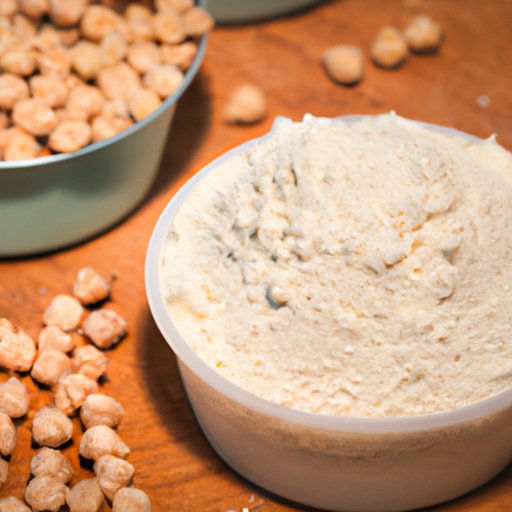
Introduction
For people with gluten intolerance, finding safe to eat ingredients can be a challenge. Gluten is a protein found in wheat, barley, and rye that can trigger an autoimmune response in people with celiac disease. Some people also choose to avoid gluten for other health reasons. Gram flour, also known as chickpea flour, is a popular ingredient in many cuisines and has been a topic of discussion among those who follow a gluten-free diet. In this article, we will explore the truth about gram flour and its relation to gluten.
Understanding Gram Flour: Is it Safe to Eat for Gluten-Free Diets?
A gluten-free diet is a dietary approach that excludes foods containing gluten. Gluten-free diets are essential for people with celiac disease, gluten sensitivity, and wheat allergy. Turning to a gluten-free diet can improve digestion, reduce inflammation, and boost energy levels.
Gram flour, also called besan or chickpea flour, is made from ground chickpeas and is a staple ingredient in many Indian, Pakistani, and Middle Eastern dishes. Gram flour contains higher protein and lower carbohydrates than wheat flour and is rich in fiber, iron, folate, and vitamin B6.
But is gram flour safe for people on a gluten-free diet? The answer is yes, in most cases. Gram flour is naturally gluten-free as it is made from chickpeas, which do not contain gluten. However, cross-contamination can occur during processing or packaging, leading to the addition of gluten to the flour. Therefore, it is essential to check the label and ensure that the product is certified gluten-free before purchasing.
The Truth About Gram Flour and Gluten: Separating Fact from Fiction
There are many misconceptions about gram flour and gluten. One of the most significant myths is that gram flour contains gluten due to the name ‘flour,’ but this is not accurate. Gram flour comes from chickpeas, which are entirely gluten-free.
Several studies have shown that gram flour is safe for people with celiac disease. However, it is essential to understand that not all gram flour products are safe. The variation in gluten levels in gram flour can depend on the brand, the origin of the chickpea, and the processing technique used. Therefore, always check the label and opt for products that are certified gluten-free.
Moreover, people tend to use gram flour as an alternative to wheat flour in recipes, assuming that it contains the same gluten content. However, the properties of gram flour are different from wheat flour, and it can not be used as a one-to-one substitute.
All You Need to Know About Gram Flour and Gluten-Free Cooking
Gram flour is incredibly versatile and can be used to make various gluten-free recipes. The nutty and earthy flavor of gram flour makes it perfect for savory dishes. It can be used to make flatbreads, vegetable pancakes, dumplings, and even as a thickening agent in soups and curries.
When cooking with gram flour, it is essential to take care of the texture. Gram flour has a unique texture and can be used to make crispy and crunchy dishes. For example, it can be used to coat vegetables for frying or as a binding agent for veggie burgers.
To store gram flour, place it in an airtight container in a cool and dark place. It can last up to six months in the pantry. However, it is recommended to keep it in the refrigerator to prolong its shelf life.
Gram Flour: A Delicious and Gluten-Free Alternative for Your Kitchen
Gram flour is an incredibly versatile and delicious gluten-free alternative to wheat flour. It has a unique nutty flavor and a dense texture that makes it ideal for many recipes. In addition, it contains an abundance of nutrients, making it a healthy alternative to wheat flour.
Gram flour can be used to make various recipes, including flatbreads, savory pancakes, and fried snacks. It is an excellent ingredient for vegan and vegetarian cooking and can be used to add protein to dishes. Also, the texture of gram flour makes it perfect for gluten-free baking and can be used to make gluten-free cakes, cookies, and muffins.
Gram flour is an acquired taste, and some people may find it hard to appreciate its flavor and texture. However, it is worth experimenting with different recipes to find the right balance of flavors that work for you.
Cooking with Confidence: How to Incorporate Gram Flour into Your Gluten-Free Diet
If you are new to cooking with gram flour, the best way to get started is to experiment with different recipes. Here are some tips for cooking with gram flour:
- Use gram flour as a thickening agent in soups and curries.
- Make flatbreads and pancakes using gram flour.
- Coat vegetables with gram flour for frying.
- Use gram flour to make veggie burgers and patties.
- Make gluten-free sweets using gram flour.
Here are some recipes to start using gram flour:
- Chickpea flour pancakes with vegetables
- Gram flour flatbread
- Vegan chickpea flour omelet
- Chickpea flour pizza crust
- Gram flour chocolate cake
Remember to check the label and opt for certified gluten-free gram flour products.
Conclusion
Gram flour is a versatile and delicious gluten-free alternative to wheat flour. It is made from chickpeas, which are entirely gluten-free, making it safe for people with celiac disease. While the gluten content in gram flour can vary depending on the brand and processing techniques used, it is recommended to opt for certified gluten-free products. Gram flour can be used to make delicious and nutritious recipes, and it is an excellent ingredient for vegan and vegetarian diets.
Start experimenting with gram flour in your cooking and discover the unique flavors and textures it has to offer.





